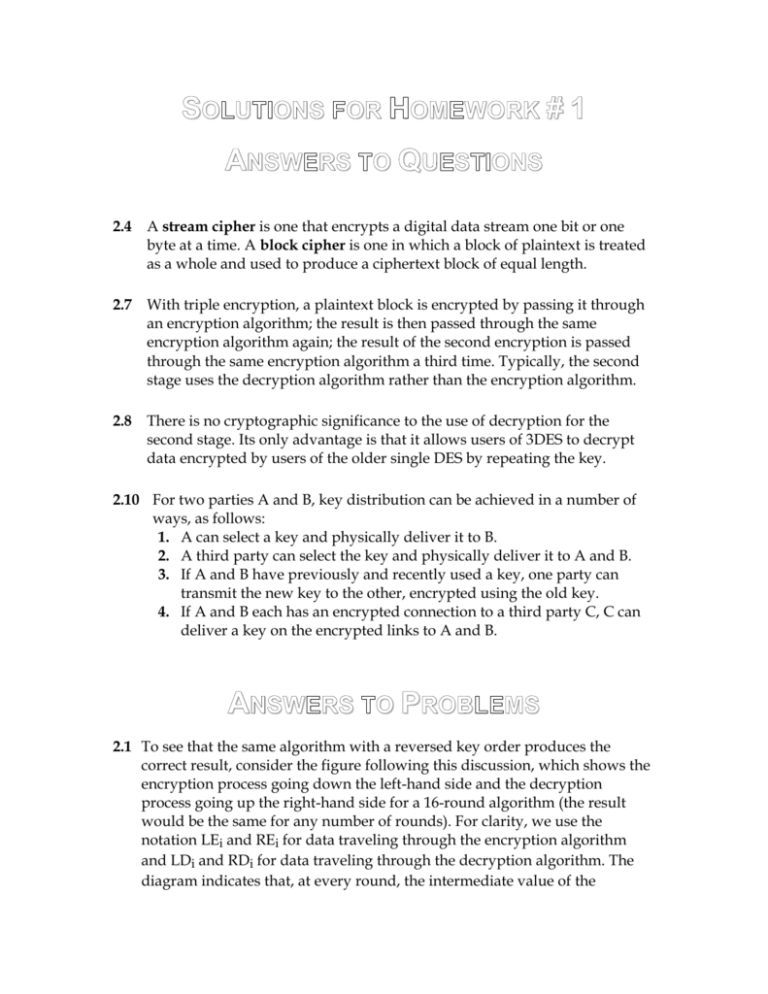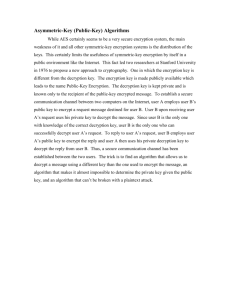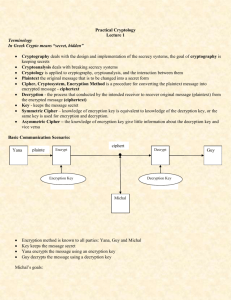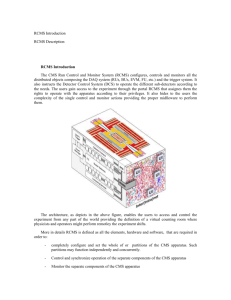SOLUTIONS FOR HOMEWORK # 1
advertisement

SOLUTIONS FOR HOMEWORK # 1 ANSWERS TO QUESTIONS 2.4 A stream cipher is one that encrypts a digital data stream one bit or one byte at a time. A block cipher is one in which a block of plaintext is treated as a whole and used to produce a ciphertext block of equal length. 2.7 With triple encryption, a plaintext block is encrypted by passing it through an encryption algorithm; the result is then passed through the same encryption algorithm again; the result of the second encryption is passed through the same encryption algorithm a third time. Typically, the second stage uses the decryption algorithm rather than the encryption algorithm. 2.8 There is no cryptographic significance to the use of decryption for the second stage. Its only advantage is that it allows users of 3DES to decrypt data encrypted by users of the older single DES by repeating the key. 2.10 For two parties A and B, key distribution can be achieved in a number of ways, as follows: 1. A can select a key and physically deliver it to B. 2. A third party can select the key and physically deliver it to A and B. 3. If A and B have previously and recently used a key, one party can transmit the new key to the other, encrypted using the old key. 4. If A and B each has an encrypted connection to a third party C, C can deliver a key on the encrypted links to A and B. ANSWERS TO PROBLEMS 2.1 To see that the same algorithm with a reversed key order produces the correct result, consider the figure following this discussion, which shows the encryption process going down the left-hand side and the decryption process going up the right-hand side for a 16-round algorithm (the result would be the same for any number of rounds). For clarity, we use the notation LEi and REi for data traveling through the encryption algorithm and LDi and RDi for data traveling through the decryption algorithm. The diagram indicates that, at every round, the intermediate value of the decryption process is equal to the corresponding value of the encryption process with the two halves of the value swapped. To put this another way, let the output of the ith encryption round be LEi||REi (Li concatenated with Ri). Then the corresponding input to the (16 – i)th decryption round is RDi||LDi. Let us walk through the figure to demonstrate the validity of the preceding assertions. To simplify the diagram, it is unwrapped, not showing the swap that occurs at the end of each iteration. But note that the intermediate result at the end of the ith stage of the encryption process is the 2w-bit quantity formed by concatenating LEi and REi, and that the intermediate result at the end of the ith stage of the decryption process is the 2w-bit quantity formed by concatenating LDi and RDi. After the last iteration of the encryption process, the two halves of the output are swapped, so that the ciphertext is RE16||LE16. The output of that round is the ciphertext. Now take that ciphertext and use it as input to the same algorithm. The input to the first round is RE16||LE16, which is equal to the 32-bit swap of the output of the sixteenth round of the encryption process. Now we would like to show that the output of the first round of the decryption process is equal to a 32-bit swap of the input to the sixteenth round of the encryption process. First, consider the encryption process. We see that: LE16 = RE15 RE16 = LE15 F(RE15, K16) On the decryption side: LD1 RD1 = = = = RD0 = LE16 = RE15 LD0 F(RD0, K16) RE16 F(RE15, K16) [LE15 F(RE15,K16)] F(RE15, K16) The XOR has the following properties: [A B] C = A [B C] DD=0 E0=E Thus, we have LD1 = RE15 and RD1 = LE15. Therefore, the output of the first round of the decryption process is LE15||RE15, which is the 32-bit swap of the input to the sixteenth round of the encryption. This correspondence holds all the way through the 16 iterations, as is easily shown. We can cast this process in general terms. For the ith iteration of the encryption algorithm: LEi REi = REi-1 = LEi-1 F(REi-1, Ki) Rearranging terms: REi-1 = LEi LEi-1 = REi F(REi-1, Ki) = REi F(LEi, Ki) Thus, we have described the inputs to the ith iteration as a function of the outputs, and these equations confirm the assignments shown in the righthand side of the following figure. Finally, we see that the output of the last round of the decryption process is RE0||LE0. A 32-bit swap recovers the original plaintext, demonstrating the validity of the Feistel decryption process. Output (plaintext) Input (plaintext) LE0 RE1 RE15 RE16 RD16 = LE 0 LE1 K2 RE2 K 15 RE14 RD15 = LE 1 K1 LD15 = RE1 F LD14 = RE2 K2 LD2 = RE14 F K 16 F RD14 = LE 2 RD2 = LE 14 F LE15 F LE16 LD16 = RE0 F LE2 LD16 = RE0 RE0 K1 F LE14 RD16 = LE 0 RE16 LE16 Output (ciphertext) RD1 = LE 15 K 15 LD1 = RE15 F LD0 = RE16 K 16 RD0 = LE 16 Input (ciphertext) 2.3 Nine plaintext characters are affected. The plaintext character corresponding to the ciphertext character is obviously altered. In addition, the altered ciphertext character enters the shift register and is not removed until the next eight characters are processed. 2.5 Yes. The eavesdropper is left with two strings, one sent in each direction, and their XOR is the secret key.







